Sightseeing
Bagno di Romagna
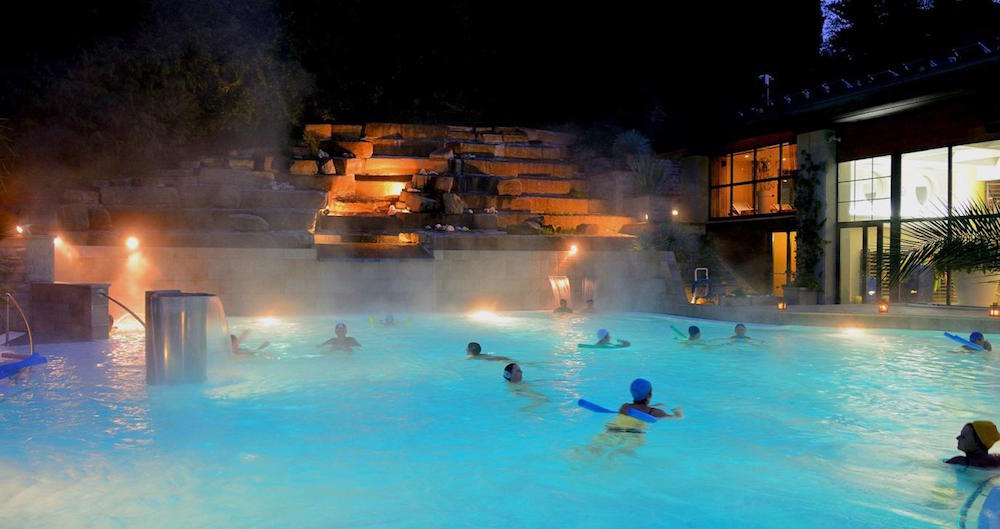
Located in the picturesque valley town of Bagno di Romagna, the thermal spa offers guests the perfect setting to relax and unwind. The large pool is separated into indoor and outdoor sections, enabling visitors to take in the breathtaking views or gaze up into the night sky. This beautiful spa also boasts Jacuzzis, waterfalls and a steam cave.
The ancients considered the thermal waters of Bagno di Romagna to come from the gods, a precious health-giving gift from the mysterious depths of the earth. Today, geologists can explain that the gift is not actually heaven-sent, but a little "miracle" of nature.
The warm waters are in fact rain that fell some 10,000 years ago in the central part of the Tuscan-Romagna Apennines. During these millennia, the water seeped down into the subsoil and was heated geothermically and enriched with beneficial properties. The water became a concentrate of active natural elements including sulphur, bicarbonate, sodium, potassium, calcium, magnesium, fluorine, chlorine, lithium, manganese, iron and ammonium. It then rose towards the surface along a fault line until it reached Bagno di Romagna where it now flows at temperatures between 39 °C and 47 °C.
The water that now flows out is physiological because it contains active elements that correspond to those of the human body. It is also medicinal and can therefore change and positively influence the conditions of the human body. It is easily tolerated because it has none of the side effects of drugs. Finally, the water at the thermal spa in Bagno di Romagna can be used to treat certain diseases and, above all, to prevent them, because it activates the body's natural defences.
The ancients considered the thermal waters of Bagno di Romagna to come from the gods, a precious health-giving gift from the mysterious depths of the earth. Today, geologists can explain that the gift is not actually heaven-sent, but a little "miracle" of nature.
The warm waters are in fact rain that fell some 10,000 years ago in the central part of the Tuscan-Romagna Apennines. During these millennia, the water seeped down into the subsoil and was heated geothermically and enriched with beneficial properties. The water became a concentrate of active natural elements including sulphur, bicarbonate, sodium, potassium, calcium, magnesium, fluorine, chlorine, lithium, manganese, iron and ammonium. It then rose towards the surface along a fault line until it reached Bagno di Romagna where it now flows at temperatures between 39 °C and 47 °C.
The water that now flows out is physiological because it contains active elements that correspond to those of the human body. It is also medicinal and can therefore change and positively influence the conditions of the human body. It is easily tolerated because it has none of the side effects of drugs. Finally, the water at the thermal spa in Bagno di Romagna can be used to treat certain diseases and, above all, to prevent them, because it activates the body's natural defences.
The Monastery of La Verna
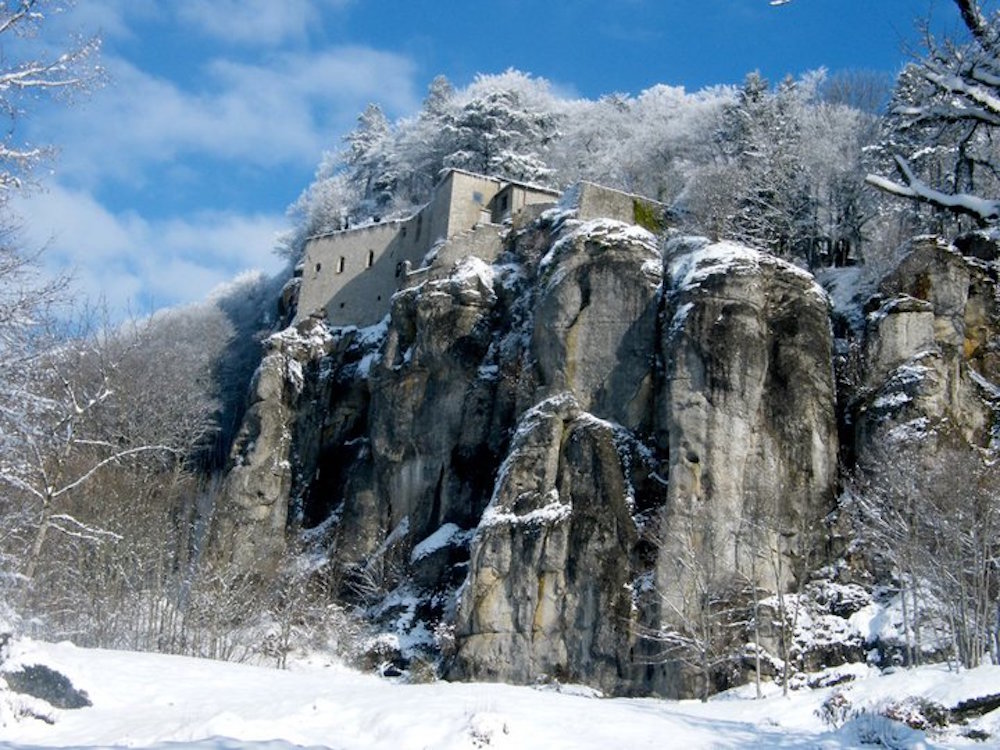
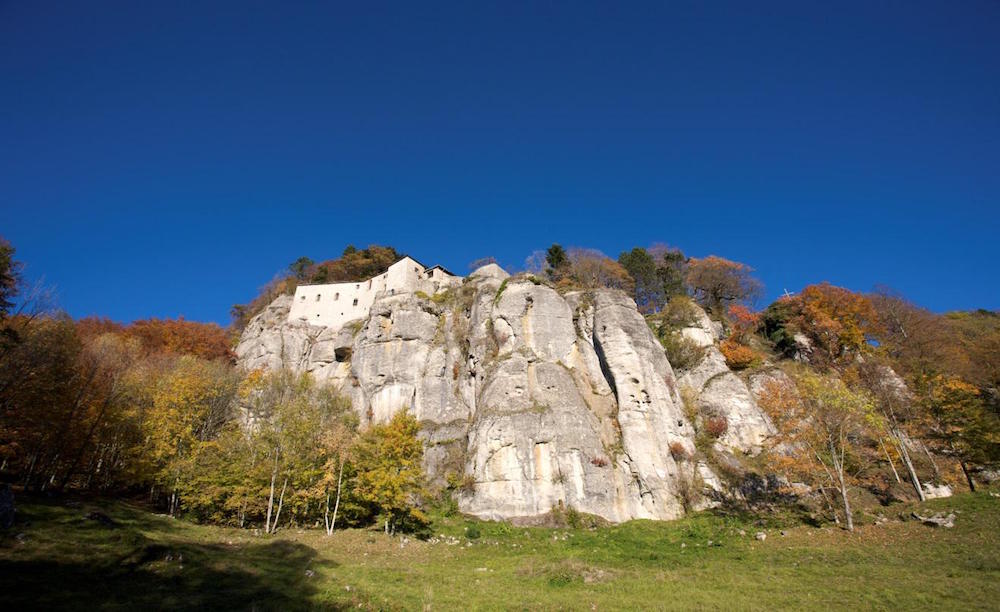
Only a short drive from the villa, La Verna, is a locality on Mount Penna, an isolated mountain of 1,283 m in the centre of the Tuscan Apennines, rising above the valley of the Casentino.Count Orlando of Chiusi gave La Verna to Francis on May 8th 1213 as a retreat specially favourable for contemplation, and in 1218 built him the chapel Santa Maria degli Angeli. In August, 1224, Francis withdrew to La Verna to keep a forty days fast in preparation for Michaelmas and while praying on the mountain-side, he is said to have had a vision on or about September 14, as a result of which he received the stigmata. Brother Leo, who had been with Francis at the time, left a clear and simple account of the event, the first definite account of the phenomenon of stigmata. "Suddenly he saw a vision of a seraph, a six-winged angel on a cross. This angel gave him the gift of the five wounds of Christ."
Thus La Verna came to be seen as sacred ground. Pope Alexander IV took it under his protection, and in 1260 a church was consecrated there in presence of St. Bonaventure & several bishops. A few years later the Chapel of the Stigmata was erected, near the spot where the miracle took place.
Thus La Verna came to be seen as sacred ground. Pope Alexander IV took it under his protection, and in 1260 a church was consecrated there in presence of St. Bonaventure & several bishops. A few years later the Chapel of the Stigmata was erected, near the spot where the miracle took place.
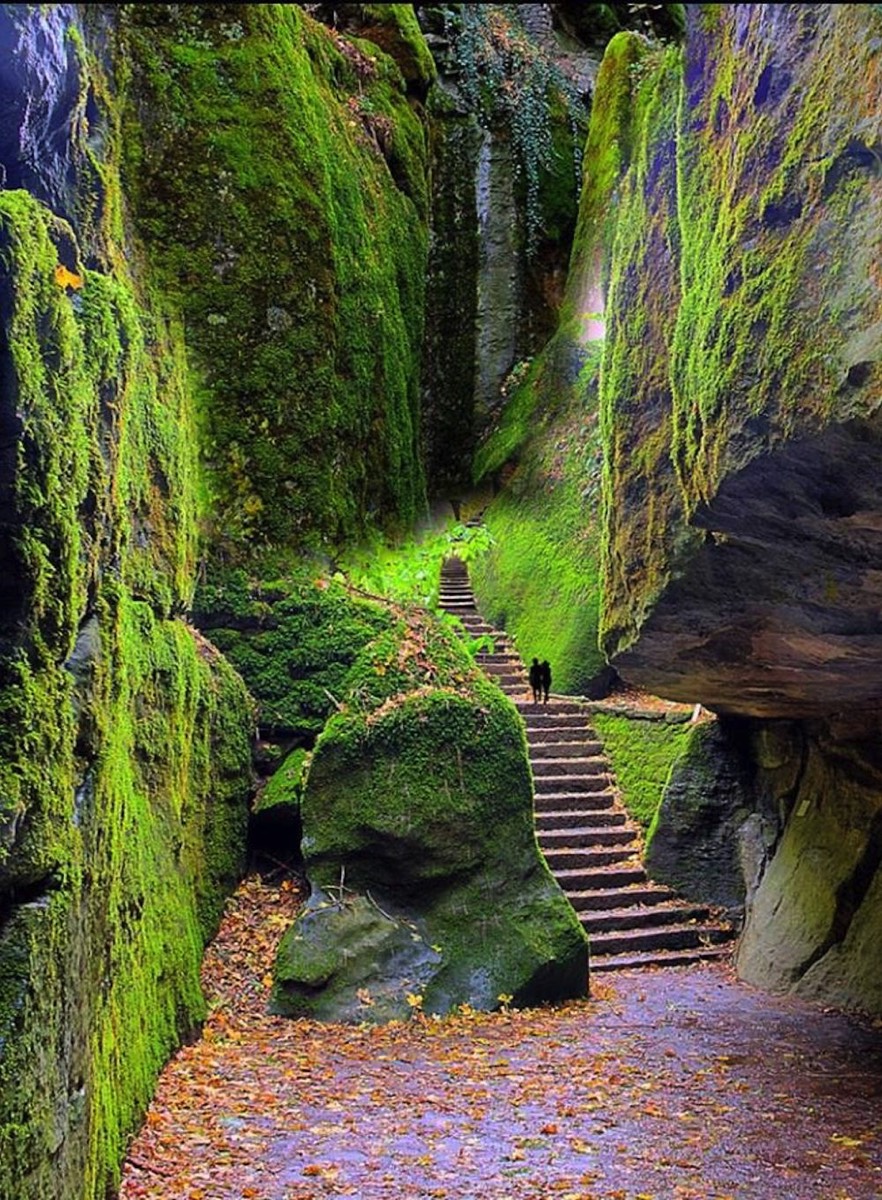
Suffering from these Stigmata and from an eye disease, he received care in several cities (Siena, Cortona, & Nocera) to no avail. In the end he was brought back to the Porziuncola (a small church in the parish of Santa Maria degli Angeli, situated about 4 kilometers from Assisi the place from where the Franciscan movement started). He was brought to the "transito," the hut for infirmed friars. Here, in the place where it all began, feeling the end approaching, he spent the last days of his life dictating his spiritual testament. He died on the evening of October 3, 1226 singing Psalm 141.
On July 16, 1228 he was pronounced a saint by the pope Gregory IX, the former cardinal Ugolino di Conti, friend and protector of St Francis. The next day, the pope laid the foundation stone for the Basilica of Saint Francis in Assisi. Saint Francis is considered the first Italian poet by literary critics. He believed commoners should be able to pray to God in their own language, and he wrote always in the dialect of Umbria instead of Latin. His writings are considered to have great literary value, as well as religious.
On July 16, 1228 he was pronounced a saint by the pope Gregory IX, the former cardinal Ugolino di Conti, friend and protector of St Francis. The next day, the pope laid the foundation stone for the Basilica of Saint Francis in Assisi. Saint Francis is considered the first Italian poet by literary critics. He believed commoners should be able to pray to God in their own language, and he wrote always in the dialect of Umbria instead of Latin. His writings are considered to have great literary value, as well as religious.
Cortona
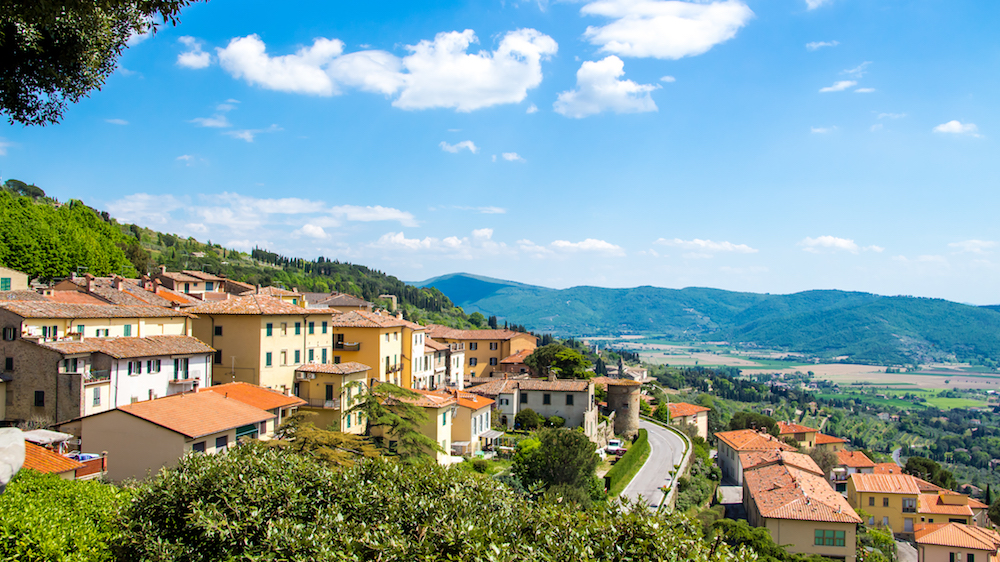
The town of Cortona was made famous by Frances Mayes book Under the Tuscan Sun, (later turned into a film) this beautiful town was put on the map by the Etruscans, just over an hour’s drive away it offers astounding views of the broad Val di Chiana, the Siena Mountains to the west, and the blue expanse of Lake Trasimeno to the south. Around the city, on terraced mountain slopes, ranks of silver-green olive trees are rooted in a stony soil, where Cortonese farmers have harvested them for centuries. A beautiful - and valuable - collection of Etruscan artefacts, are on display in Cortona's Museo dell'Accademia (Palazzo Casali). The walls of Cortona, run for approximately 3 kilometers, enclosing a well-preserved and evocative medieval town with a number of piazzas, palazzos, churches, public buildings and gardens. Some of buildings are in the Romanesque style, others pure Gothic and a few with a Renaissance flourish.
During your visit take time to wander its winding medieval streets, full of wonderful shops selling locally produced goods and gifts, in places staircases,(some very steep) have been cut into the stone of the mountain. Afterwards, enjoy an espresso con biscotti at one of many cafes in and around it’s piazzas, or perhaps partake of a full Tuscan lunch at one of its many good restaurants or an excellent gelato (Ice-cream).
During your visit take time to wander its winding medieval streets, full of wonderful shops selling locally produced goods and gifts, in places staircases,(some very steep) have been cut into the stone of the mountain. Afterwards, enjoy an espresso con biscotti at one of many cafes in and around it’s piazzas, or perhaps partake of a full Tuscan lunch at one of its many good restaurants or an excellent gelato (Ice-cream).
Wine Tasting Excursion in Cortona
We take you on a drive through the beautiful Tuscan countryside with spectacular views passing through Castiglion Fiorentino to the town of Cortona which is famously the setting of the book and film “Under The Tuscan Sun”
We stroll through the main shopping street taking in all the sights sounds and smells of this stunning Tuscan town to the Romeo family shop for a wine tasting experience of their fabulous products which are all organically grown. There we meet Gabriella of the Romeo family who knows everything there is to know about wine production. You will get to taste many fine red wines including the most famous of all Italian wines the “Brunello” as well as one white wine followed by her incredible Vin Santo, Limoncello & Grappa.
Afterwards you can take a couple of hours to have lunch in a choice of wonderful pavement cafes and explore the town and shops before we meet you to bring you back to the villa
We stroll through the main shopping street taking in all the sights sounds and smells of this stunning Tuscan town to the Romeo family shop for a wine tasting experience of their fabulous products which are all organically grown. There we meet Gabriella of the Romeo family who knows everything there is to know about wine production. You will get to taste many fine red wines including the most famous of all Italian wines the “Brunello” as well as one white wine followed by her incredible Vin Santo, Limoncello & Grappa.
Afterwards you can take a couple of hours to have lunch in a choice of wonderful pavement cafes and explore the town and shops before we meet you to bring you back to the villa
Anghiari
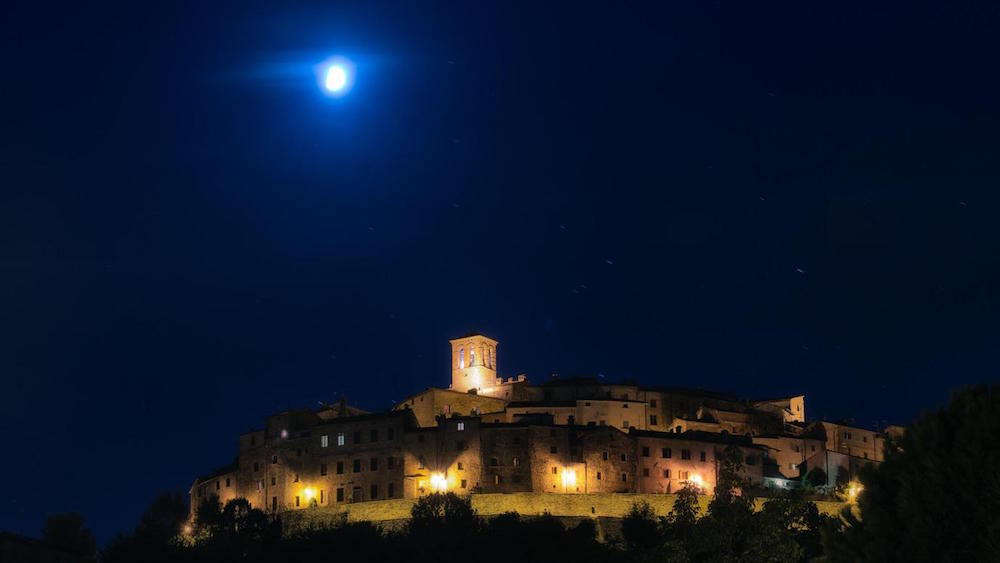
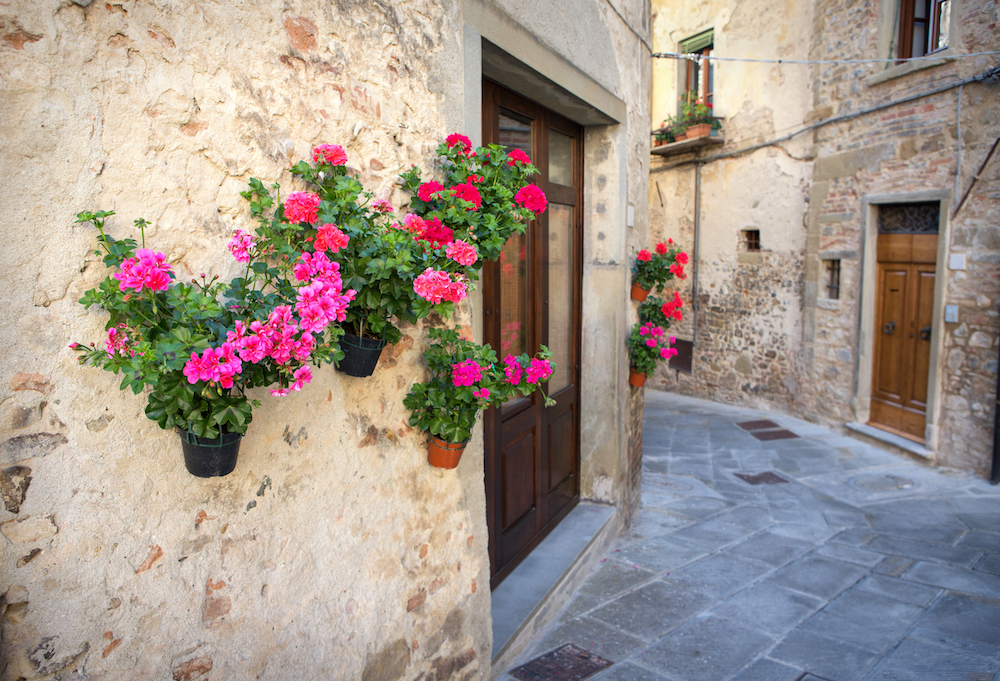
A mere 20 minute drive away the lovely medieval town of Anghiari lies between two rivers, the Tiber and the Arno. It’s powerful thirteenth century walls made the town an invincible fortress which constituted an important reference point and kept the Tuscan flag flying during the many historical events that occurred in this delicately balanced border area. Surrounded by castles and country churches Anghiari looks out over the beautiful High Tiber Valley landscape, a natural amphitheatre filled with the spirituality of St. Francis of Assisi. The countryside around Anghiari has an untouched atmosphere with ancient woods dotted with monasteries and archaeological sites. Artisan shops and the workrooms of furniture and antiques restorers enrich the small squares of the town; its towers and churches are embellished with masterpieces of painting and sculpture and there are breathtaking views and vistas to be found from every corner of the ancient town.
Often referred to as the "The Lost Leonardo", The Battle of Anghiari is a lost painting by Leonardo da Vinci, which some commentators believe lies hidden beneath later frescoes in the Hall of Five Hundred (Salone dei Cinquecento) in the Palazzo Vecchio, Florence. Its central scene depicted a fierce fight between two men mounted on raging war-horses, during the The Battle of Anghiari (1440), a battle between the Florentine Republic and a Milanese army which took place on the plain outside the city walls. Incidentally when Machiavelli subsequently wrote about it he pointed out ironically that twenty or twenty four hours of skirmishing only produced one death and that when a soldier fell off his horse.
Often referred to as the "The Lost Leonardo", The Battle of Anghiari is a lost painting by Leonardo da Vinci, which some commentators believe lies hidden beneath later frescoes in the Hall of Five Hundred (Salone dei Cinquecento) in the Palazzo Vecchio, Florence. Its central scene depicted a fierce fight between two men mounted on raging war-horses, during the The Battle of Anghiari (1440), a battle between the Florentine Republic and a Milanese army which took place on the plain outside the city walls. Incidentally when Machiavelli subsequently wrote about it he pointed out ironically that twenty or twenty four hours of skirmishing only produced one death and that when a soldier fell off his horse.
Olive Oil Mill Tour & Tasting Excursion
Enjoy an authentic Italian experience at the local olive oil mill. The mill dates back to 1421 and is still in use to this day.
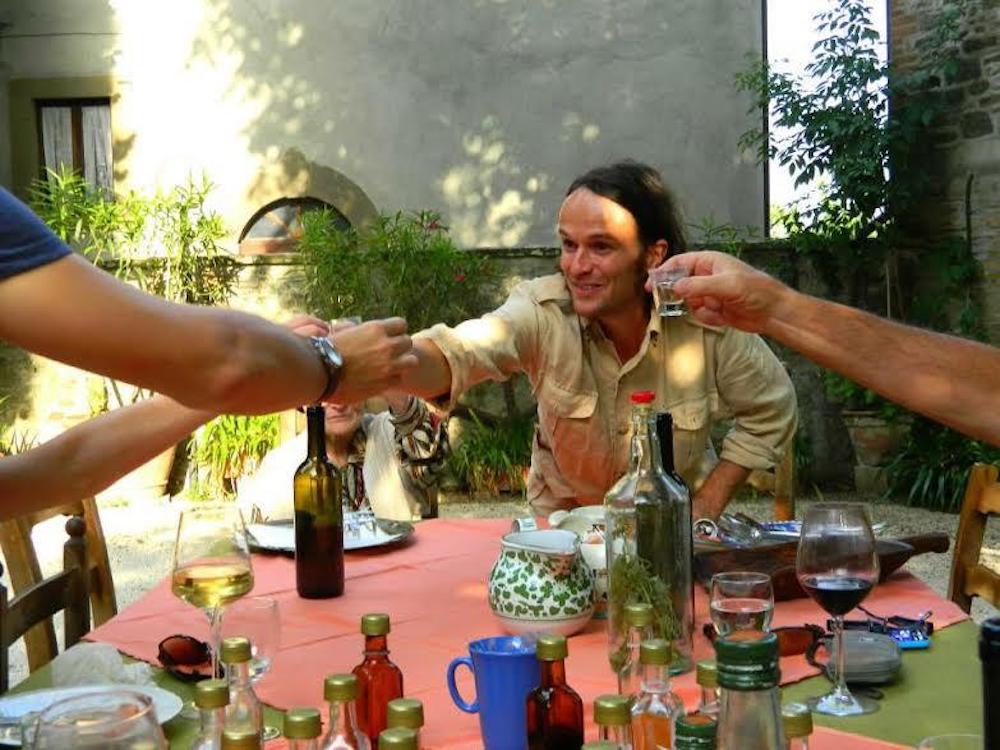
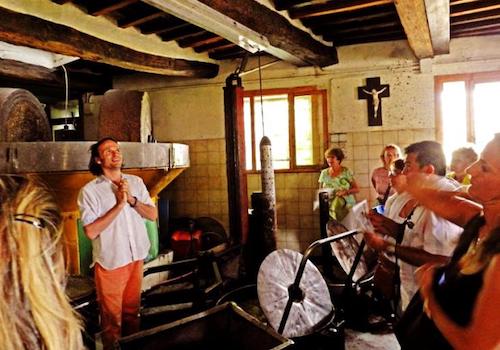
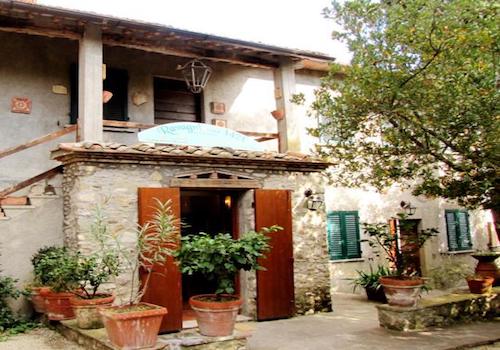
This wonderful experience of visiting an oil mill is fantastic. First you will have a little tour of the mill and then you go to the family residence where you will enjoy a fresh and delicious meal complete with wine made from the grapes from their own vineyard in the courtyard. This is preceded by an opportunity to taste the many variations on their own oils. Particularly remarked upon, are the fennel, lemon, black and white truffle and basil flavoured oils.
Cesenatico
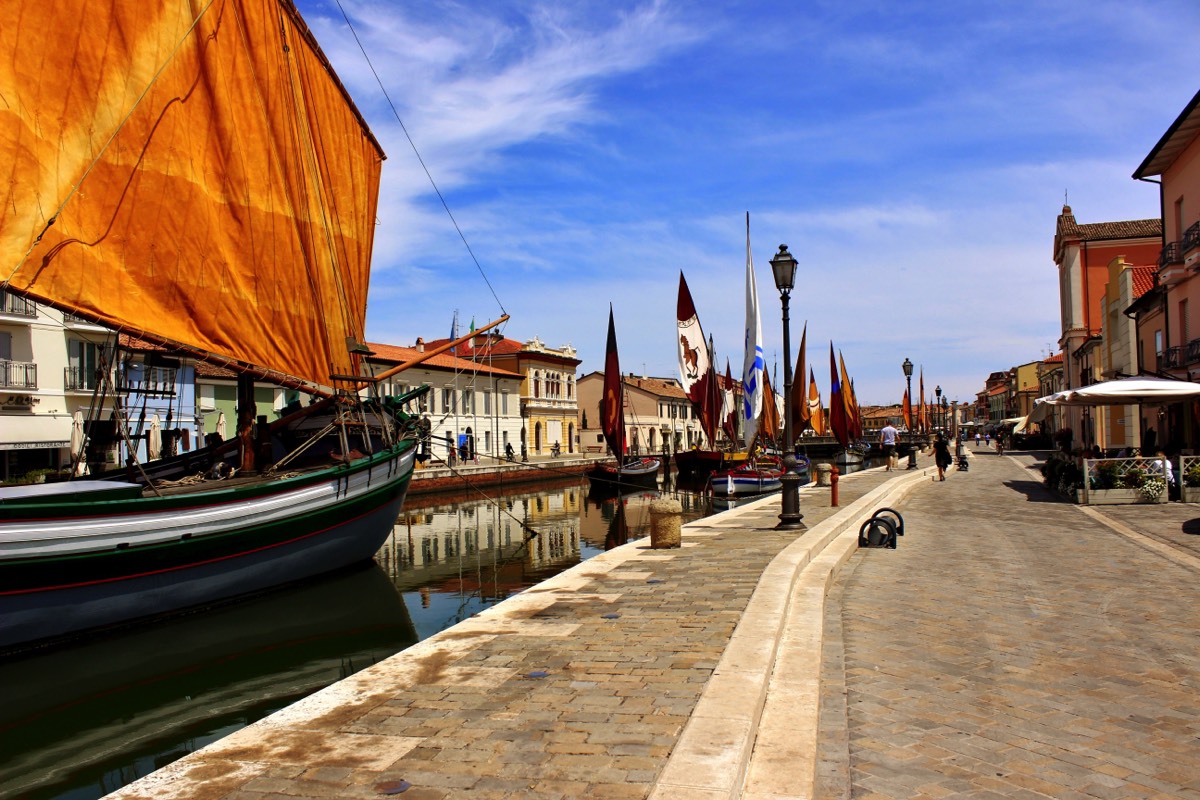
The nearest beach is on the Adriatic coast only an hour’s drive from here.
Cesenatico is a beautiful harbour town with a golden sandy beach and many shops and restaurants.
Cesenatico is a beautiful harbour town with a golden sandy beach and many shops and restaurants.
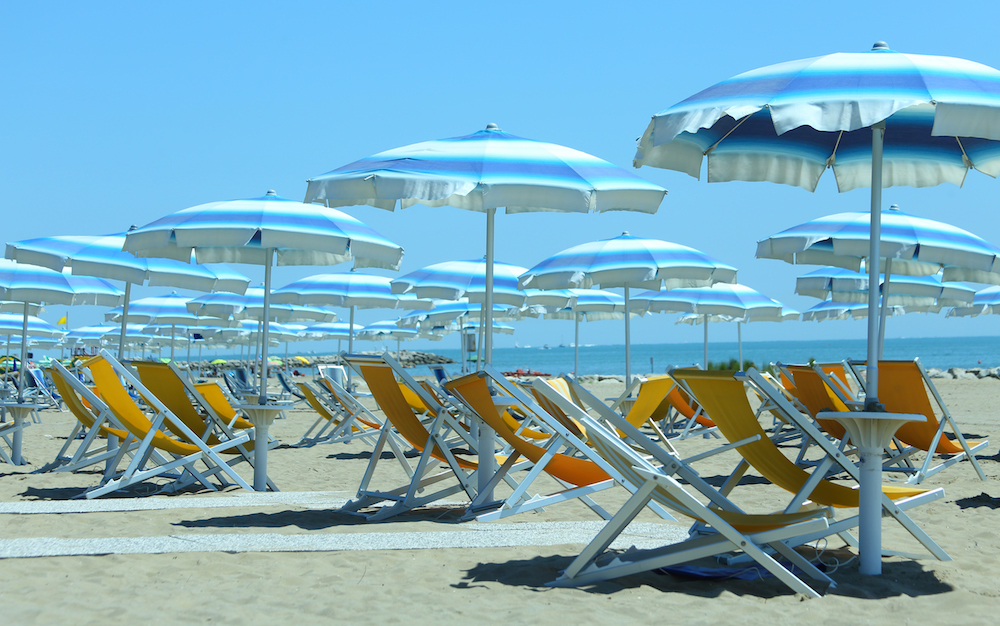
Florence
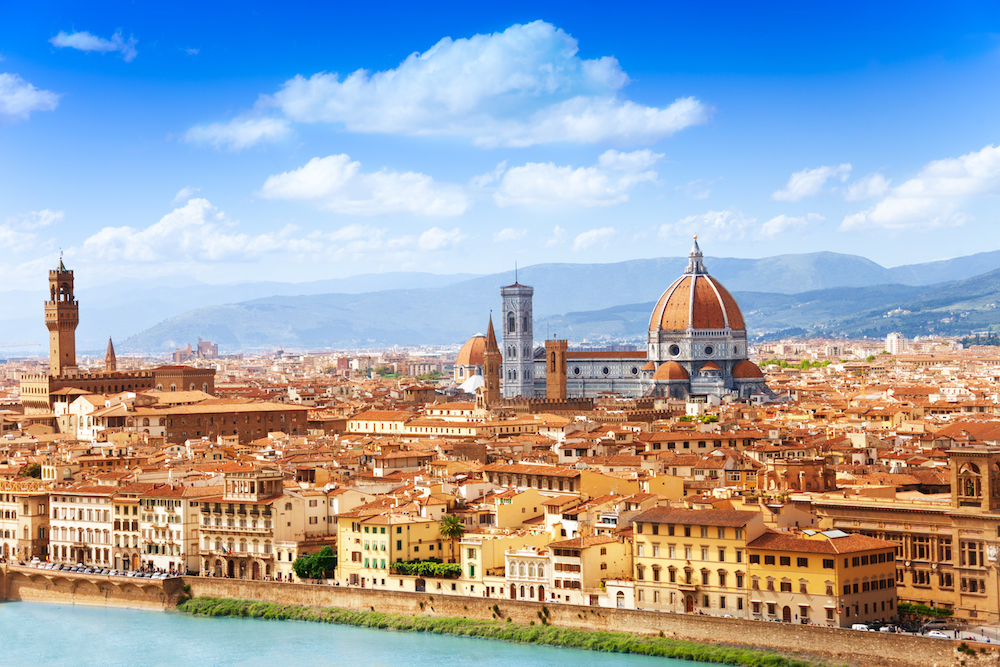
One of Italy's most famous cities, Florence (in Italian 'Firenze') is famed as the birthplace of the Renaissance it preserves some of the greatest works of art and most beautiful buildings in the world.
From the 15th century onwards it became a centre of learning in the arts and sciences unparalleled since classical times. Now a small city, the regional capital of Tuscany, has nearly all its beautiful buildings concentrated within a relatively small area. These include the famous museums of the Uffizi that contains one of the World’s most important art collections with the paintings of Boticelli, da Vinci and many others. The stunning Duomo made of Carrara Marble is a masterpiece of the renaissance dedicated to Santa Maria del Fiore. The Palazzo Pitti and Bargello are home to other classical pieces of Florentine art. The Galleria dell'Accademia with it’s sculptures by Michelangelo and Florentine paintings. The Gothic church of Santa Croce is the burial place of Michelangelo, Machiavelli, Galileo and others. Spanning the river Arno the Ponte Vecchio is not only a means of crossing the river but the home of a myriad of quaint jewellery shops, offering traditional and modern pieces. The Boboli Gardens, are home to a distinguished collection of sculptures dating from the sixteenth through the eighteenth centuries, with some Roman antiquities. Surrounding the historical treasures are streets packed with fashion boutiques all the famous names are here Versace, Gucci, Valentino, Roberto Cavelli, Prada to name a few.
Above the city is the Piazzala Michelangelo not only offers astounding views but allows the visitor to purchase gifts & souvenirs as well as refreshments or even one of Italy’s famous ice creams.
From the 15th century onwards it became a centre of learning in the arts and sciences unparalleled since classical times. Now a small city, the regional capital of Tuscany, has nearly all its beautiful buildings concentrated within a relatively small area. These include the famous museums of the Uffizi that contains one of the World’s most important art collections with the paintings of Boticelli, da Vinci and many others. The stunning Duomo made of Carrara Marble is a masterpiece of the renaissance dedicated to Santa Maria del Fiore. The Palazzo Pitti and Bargello are home to other classical pieces of Florentine art. The Galleria dell'Accademia with it’s sculptures by Michelangelo and Florentine paintings. The Gothic church of Santa Croce is the burial place of Michelangelo, Machiavelli, Galileo and others. Spanning the river Arno the Ponte Vecchio is not only a means of crossing the river but the home of a myriad of quaint jewellery shops, offering traditional and modern pieces. The Boboli Gardens, are home to a distinguished collection of sculptures dating from the sixteenth through the eighteenth centuries, with some Roman antiquities. Surrounding the historical treasures are streets packed with fashion boutiques all the famous names are here Versace, Gucci, Valentino, Roberto Cavelli, Prada to name a few.
Above the city is the Piazzala Michelangelo not only offers astounding views but allows the visitor to purchase gifts & souvenirs as well as refreshments or even one of Italy’s famous ice creams.
Sansepolcro
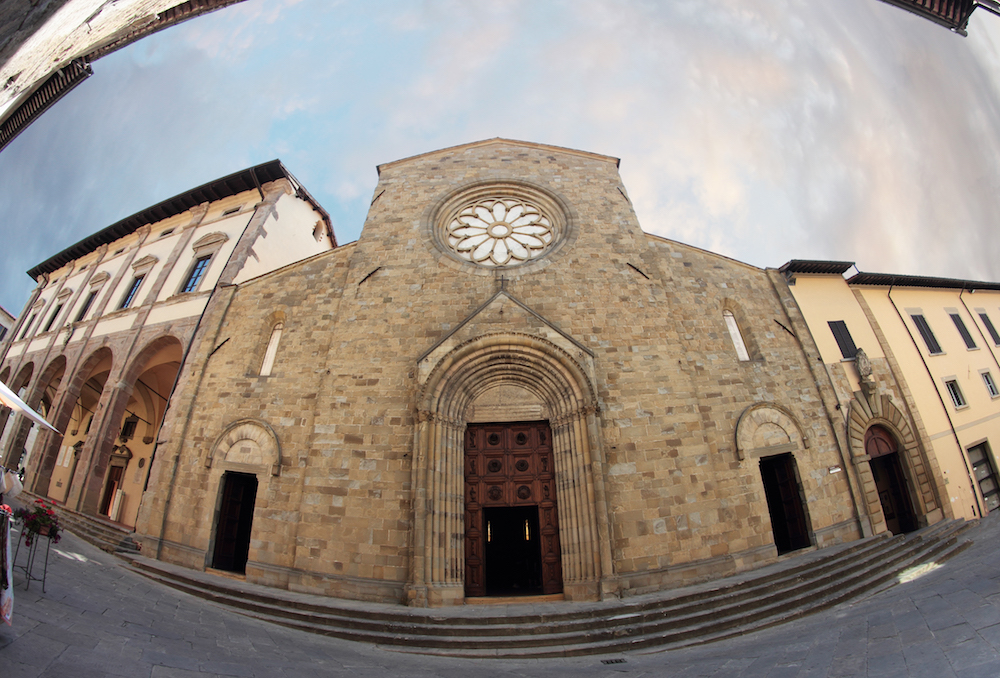
The town and commune of Sansepolcro is a half hour drive away on the Tiber river, it is the birthplace of the painters Piero della Francesca, Raffaellino del Colle (a pupil of Raphael ) and Angiolo Tricca, along with the Italian mathematician Luca Pacioli. Surrounded by the fertile plains of the upper Tiber valley where tobacco is a major cash crop, Sansepolcro was where Giulia Boninsegni and Gio Batta Buitoni started their production of pasta in 1827, the first pasta factory in Italy, and one of their old factories still stands inside the town. The durum wheat used in pasta was imported mainly from Apulia. Buitoni now belongs to Nestlé but retains a strong presence in the area.
A strange chain of events saved this beautiful town from being irreparably damaged during World War 2, Occupied by the retreating Germans British Artillery Captain Anthony Clarke was tasked with directing the bombardment to remove them, as it started he remembered where he had heard of the town, it was an article by Aldous Huxley in which he described The Resurrection by Piero Della Francesca housed in the town’s Museo Civico as "the greatest painting in the world". Although he had never seen the painting he ordered his men to stop. It transpired that the Germans had already departed from the area - the bombardment hadn't been necessary and the town, along with its famous painting survived.
In Sansepolcro’s narrow streets you will find a wide variety of small shops and boutiques, along with a host of cafes and a wide selection of restaurants offering everything from the traditional pizza to exquisite a la carte at Guide which has an intimate romantic feel. The town also contains a number of supermarkets for our visitors to purchase provisions, one of which is contained in an indoor shopping centre just across form the historic part of the town where there is ample parking. Tuesdays and Saturdays mornings is when the town has a market and on a Friday evening there is an interesting antique bazaar.
A strange chain of events saved this beautiful town from being irreparably damaged during World War 2, Occupied by the retreating Germans British Artillery Captain Anthony Clarke was tasked with directing the bombardment to remove them, as it started he remembered where he had heard of the town, it was an article by Aldous Huxley in which he described The Resurrection by Piero Della Francesca housed in the town’s Museo Civico as "the greatest painting in the world". Although he had never seen the painting he ordered his men to stop. It transpired that the Germans had already departed from the area - the bombardment hadn't been necessary and the town, along with its famous painting survived.
In Sansepolcro’s narrow streets you will find a wide variety of small shops and boutiques, along with a host of cafes and a wide selection of restaurants offering everything from the traditional pizza to exquisite a la carte at Guide which has an intimate romantic feel. The town also contains a number of supermarkets for our visitors to purchase provisions, one of which is contained in an indoor shopping centre just across form the historic part of the town where there is ample parking. Tuesdays and Saturdays mornings is when the town has a market and on a Friday evening there is an interesting antique bazaar.
Rome
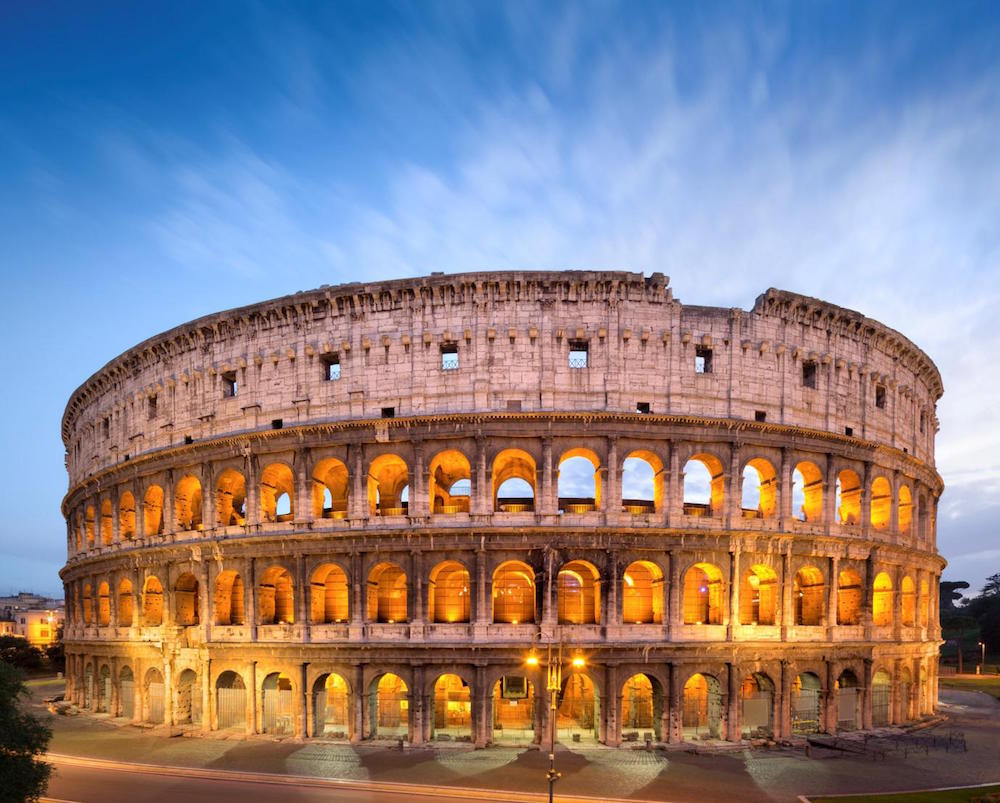
Rome, the Eternal City is easily accessible by train from Arrezzo in about 2 hours, or a 3 hour drive down the autostrada. Rome’s history spans over two and a half thousand years, as one of the founding cities of Western Civilization. Even outside of the history of the Roman Empire, Rome has a significant place in the story of Christianity up to the present day, for it endures as the home of the papacy.
The city has a cornucopia of sights on any person’s ‘must see list’ The Colosseum or Roman Coliseum, originally known as the Flavian Amphitheatre. This elliptical amphitheatre in the center of the city is one of the greatest works of Roman architecture and engineering. Occupying a site just east of the Roman Forum, its construction started between 70 and 72 AD and was completed in 80 AD, with further modifications being made during Domitian's reign; it was the largest ever built in the Roman Empire. Originally capable of seating around 80,000 spectators, the Colosseum was used for gladiatorial contests and public spectacles, such as mock sea battles, animal hunts, executions, re-enactments of famous battles, and dramas based on Classical mythology. It has been estimated that 500,000 people and over a million wild animals died during the games.
Having ceased to be used for entertainment in the early medieval era, it was later reused for such purposes as housing, workshops, quarters for a religious order, a fortress, a quarry, and a Christian shrine.
Although in the 21st century it stays partially ruined due to damage caused by devastating earthquakes and stone-robbers, the Colosseum is an iconic symbol of Imperial Rome, being depicted on the Italian version of the five-cent euro coin.
Today it is one of Rome's most popular tourist attractions and still has close connections with the Roman Catholic Church, each Good Friday the Pope leads a torch lit "Way of the Cross" procession.
Vatican City, officially the State of the Vatican City is a landlocked sovereign city-state whose territory consists of a walled enclave within the city of Rome. At approximately 44 hectares (110 acres), and with a population of around 800, it is the smallest independent state in the world by both population and area, ruled by the Bishop of Rome — the Pope a non-hereditary, elected monarchy. He is the highest state functionaries are all clergymen of the Catholic Church. It is the sovereign territory of the Holy See and the location of the Pope's residence, referred to as the Apostolic Palace.
Contained within enclave is the Basilica of Saint Peter commonly known as St. Peter's Basilica. It occupies a "unique position" as one of the holiest sites and as "the greatest of all churches of Christendom". In Catholic Tradition, it is the burial site of its namesake Saint Peter, one of the twelve apostles of Jesus and, who according to tradition, was the first Bishop of Antioch, and later first Bishop of Rome and therefore first in the line of the papal succession. While St. Peter's is the most famous of Rome's many churches, it is not the first in rank, an honour held by the Pope's cathedral church, the Basilica of St. John Lateran.
It is said that Saint Peter's tomb is below the altar of the basilica. For this reason, many Popes, starting with the first ones, have been buried there. St. Peter's is famous as a place of pilgrimage, for its liturgical functions and for its historical associations. It is associated with the papacy, with the Counter-reformation and with numerous artists, most significantly Michelangelo. As a work of architecture, it is regarded as the greatest building of its age. Contrary to popular misconception, Saint Peter's is not a cathedral, as it is not the seat of a bishop. It is properly termed a basilica.
In the Apostolic Palace, the official residence of the Pope is the Sistine Chapel probably the best-known of all the chapels, it’s fame rests on its architecture, which has been frescoed throughout by the greatest Renaissance artists including Michelangelo, Raphael, Bernini, and Sandro Botticelli. Under the patronage of Pope Julius II, Michelangelo painted 12,000 square feet (1,100 m2) of the chapel ceiling between 1508 and 1512. He resented the commission, and believed his work only served the Pope's need for grandeur. However, today the ceiling is widely believed to be Michelangelo's crowning achievement.
The Scalinata di Spagna, or Spanish Steps, are located in an upmarket area of Rome, and join the Piazza di Spagna with the church of Trinita dei Monti. Designed in 1723 by Francesco De Sanctis, and funded by a French diplomat Stefano Gueffierwas, The construction of The Spanish Steps, uses 138 steps, in a mix of curves, straight flights, vistas, and terraces. The Spanish Steps got their name from the Spanish Embassy to the Holy See which was located in the piazza. The Spanish Steps are usually very crowded during the summer months, with tourists just sitting, chatting, and taking a rest from visiting the many designer shops that litter the area. It may seem like a good place to eat a picnic lunch, but the Italian authorities, in an attempt to keep the area clean, have banned visitors from eating whilst sitting on the steps. During the 18th century, the Spanish Steps became a meeting place for both artists and models. To the right at the base of the steps, is a house where the English poet John Keats lived and died. The house is now a museum dedicated to his memory.
The Pantheon, located in Piazza della Rotunda, is one of Rome's top tourist attractions. Near to the Largo Argentina bus and tram stops, and the Spagna metro station about a 15 minute walk. The Pantheon was built as a Roman temple and later consecrated as a Catholic Church. The original Pantheon was built in 27 to 25 B.C. but was destroyed by fire, with the current building dating from about 125, built during the reign of the Emperor Hadrian. The dome rests on a cylinder of masonry walls. Hidden voids and the interior recesses allows for a lighter construction, and giving an effect of not so much a solid mass, but more like three continuous arcades, which correspond to the three tiers of relieving arches visible on the exterior of the building . Originally, the exterior walls were faced with fine marble which, over the course of the centuries, has been removed. The dome itself is constructed through the use of stepped rings made from solid concrete with gradually less and less density the higher you go.
Standing 25.9 meters (85 feet) high and 19.8 (65feet) wide The Trevi Fountain is the largest and most ambitious of Rome’s Baroque fountains. Located in the rione of Trevi, the fountain at the juncture of three roads (tre vie) marks the terminal point of one the terminal point of one of the ancient aqueducts that supplied water to ancient Rome. In 19 BC, supposedly with the help of a virgin, Roman technicians located a source of pure water some 13 km (8 miles) from the city. This scene is depicted on the façade of the fountain. However, the eventual indirect route of the aqueduct made its length some 22 km (14 miles). The water of the Aqua Virgo served Rome for more than four hundred years, ending when Goth besiegers broke the aqueducts in 537/38. Medieval Romans were reduced to drawing water from polluted wells and the Tiber River, which was also used as a sewer.
Legend holds that if a visitor throws a coin into the fountain, they are ensured a return to Rome. The Trevi also set the backdrop for the 1954 film classic Three Coins in the Fountain that introduced the song of the same name, it tells the story of three American girls looking for romance in Rome, and started the "three coins" being thrown into the fountain tradition however few realize that the coins were thrown by three different individuals. A current interpretation is that two coins will lead to a new romance and three will ensure either a marriage or divorce, or alternatively that it is lucky to throw three coins with one's right hand over one's left shoulder into the Trevi Fountain.
Approximately 3,000 Euros are thrown into the fountain each day and are collected at night. The money has been used to subsidize a supermarket for Rome's needy. However, there are regular attempts to steal coins from the fountain.
Today, Rome is a modern, cosmopolitan city, having escaped World War II relatively unscathed, central Rome remains essentially Renaissance and Baroque in character. Rome is listed as a World Heritage Site.
The city has a cornucopia of sights on any person’s ‘must see list’ The Colosseum or Roman Coliseum, originally known as the Flavian Amphitheatre. This elliptical amphitheatre in the center of the city is one of the greatest works of Roman architecture and engineering. Occupying a site just east of the Roman Forum, its construction started between 70 and 72 AD and was completed in 80 AD, with further modifications being made during Domitian's reign; it was the largest ever built in the Roman Empire. Originally capable of seating around 80,000 spectators, the Colosseum was used for gladiatorial contests and public spectacles, such as mock sea battles, animal hunts, executions, re-enactments of famous battles, and dramas based on Classical mythology. It has been estimated that 500,000 people and over a million wild animals died during the games.
Having ceased to be used for entertainment in the early medieval era, it was later reused for such purposes as housing, workshops, quarters for a religious order, a fortress, a quarry, and a Christian shrine.
Although in the 21st century it stays partially ruined due to damage caused by devastating earthquakes and stone-robbers, the Colosseum is an iconic symbol of Imperial Rome, being depicted on the Italian version of the five-cent euro coin.
Today it is one of Rome's most popular tourist attractions and still has close connections with the Roman Catholic Church, each Good Friday the Pope leads a torch lit "Way of the Cross" procession.
Vatican City, officially the State of the Vatican City is a landlocked sovereign city-state whose territory consists of a walled enclave within the city of Rome. At approximately 44 hectares (110 acres), and with a population of around 800, it is the smallest independent state in the world by both population and area, ruled by the Bishop of Rome — the Pope a non-hereditary, elected monarchy. He is the highest state functionaries are all clergymen of the Catholic Church. It is the sovereign territory of the Holy See and the location of the Pope's residence, referred to as the Apostolic Palace.
Contained within enclave is the Basilica of Saint Peter commonly known as St. Peter's Basilica. It occupies a "unique position" as one of the holiest sites and as "the greatest of all churches of Christendom". In Catholic Tradition, it is the burial site of its namesake Saint Peter, one of the twelve apostles of Jesus and, who according to tradition, was the first Bishop of Antioch, and later first Bishop of Rome and therefore first in the line of the papal succession. While St. Peter's is the most famous of Rome's many churches, it is not the first in rank, an honour held by the Pope's cathedral church, the Basilica of St. John Lateran.
It is said that Saint Peter's tomb is below the altar of the basilica. For this reason, many Popes, starting with the first ones, have been buried there. St. Peter's is famous as a place of pilgrimage, for its liturgical functions and for its historical associations. It is associated with the papacy, with the Counter-reformation and with numerous artists, most significantly Michelangelo. As a work of architecture, it is regarded as the greatest building of its age. Contrary to popular misconception, Saint Peter's is not a cathedral, as it is not the seat of a bishop. It is properly termed a basilica.
In the Apostolic Palace, the official residence of the Pope is the Sistine Chapel probably the best-known of all the chapels, it’s fame rests on its architecture, which has been frescoed throughout by the greatest Renaissance artists including Michelangelo, Raphael, Bernini, and Sandro Botticelli. Under the patronage of Pope Julius II, Michelangelo painted 12,000 square feet (1,100 m2) of the chapel ceiling between 1508 and 1512. He resented the commission, and believed his work only served the Pope's need for grandeur. However, today the ceiling is widely believed to be Michelangelo's crowning achievement.
The Scalinata di Spagna, or Spanish Steps, are located in an upmarket area of Rome, and join the Piazza di Spagna with the church of Trinita dei Monti. Designed in 1723 by Francesco De Sanctis, and funded by a French diplomat Stefano Gueffierwas, The construction of The Spanish Steps, uses 138 steps, in a mix of curves, straight flights, vistas, and terraces. The Spanish Steps got their name from the Spanish Embassy to the Holy See which was located in the piazza. The Spanish Steps are usually very crowded during the summer months, with tourists just sitting, chatting, and taking a rest from visiting the many designer shops that litter the area. It may seem like a good place to eat a picnic lunch, but the Italian authorities, in an attempt to keep the area clean, have banned visitors from eating whilst sitting on the steps. During the 18th century, the Spanish Steps became a meeting place for both artists and models. To the right at the base of the steps, is a house where the English poet John Keats lived and died. The house is now a museum dedicated to his memory.
The Pantheon, located in Piazza della Rotunda, is one of Rome's top tourist attractions. Near to the Largo Argentina bus and tram stops, and the Spagna metro station about a 15 minute walk. The Pantheon was built as a Roman temple and later consecrated as a Catholic Church. The original Pantheon was built in 27 to 25 B.C. but was destroyed by fire, with the current building dating from about 125, built during the reign of the Emperor Hadrian. The dome rests on a cylinder of masonry walls. Hidden voids and the interior recesses allows for a lighter construction, and giving an effect of not so much a solid mass, but more like three continuous arcades, which correspond to the three tiers of relieving arches visible on the exterior of the building . Originally, the exterior walls were faced with fine marble which, over the course of the centuries, has been removed. The dome itself is constructed through the use of stepped rings made from solid concrete with gradually less and less density the higher you go.
Standing 25.9 meters (85 feet) high and 19.8 (65feet) wide The Trevi Fountain is the largest and most ambitious of Rome’s Baroque fountains. Located in the rione of Trevi, the fountain at the juncture of three roads (tre vie) marks the terminal point of one the terminal point of one of the ancient aqueducts that supplied water to ancient Rome. In 19 BC, supposedly with the help of a virgin, Roman technicians located a source of pure water some 13 km (8 miles) from the city. This scene is depicted on the façade of the fountain. However, the eventual indirect route of the aqueduct made its length some 22 km (14 miles). The water of the Aqua Virgo served Rome for more than four hundred years, ending when Goth besiegers broke the aqueducts in 537/38. Medieval Romans were reduced to drawing water from polluted wells and the Tiber River, which was also used as a sewer.
Legend holds that if a visitor throws a coin into the fountain, they are ensured a return to Rome. The Trevi also set the backdrop for the 1954 film classic Three Coins in the Fountain that introduced the song of the same name, it tells the story of three American girls looking for romance in Rome, and started the "three coins" being thrown into the fountain tradition however few realize that the coins were thrown by three different individuals. A current interpretation is that two coins will lead to a new romance and three will ensure either a marriage or divorce, or alternatively that it is lucky to throw three coins with one's right hand over one's left shoulder into the Trevi Fountain.
Approximately 3,000 Euros are thrown into the fountain each day and are collected at night. The money has been used to subsidize a supermarket for Rome's needy. However, there are regular attempts to steal coins from the fountain.
Today, Rome is a modern, cosmopolitan city, having escaped World War II relatively unscathed, central Rome remains essentially Renaissance and Baroque in character. Rome is listed as a World Heritage Site.
Gubbio
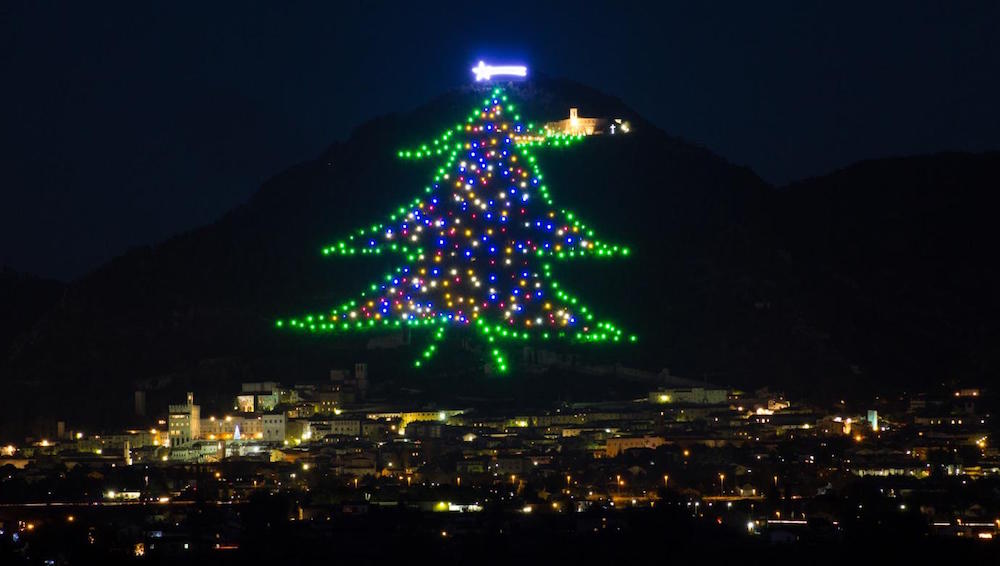
Gubbio is nearby and has the World’s largest Christmas tree as the whole side of the mountain is lit up in the shape of a Christmas tree reaching 2600ft . A spectacular place to visit in December with the whole town set out as a Nativity and full of shops and restaurants .
Venice
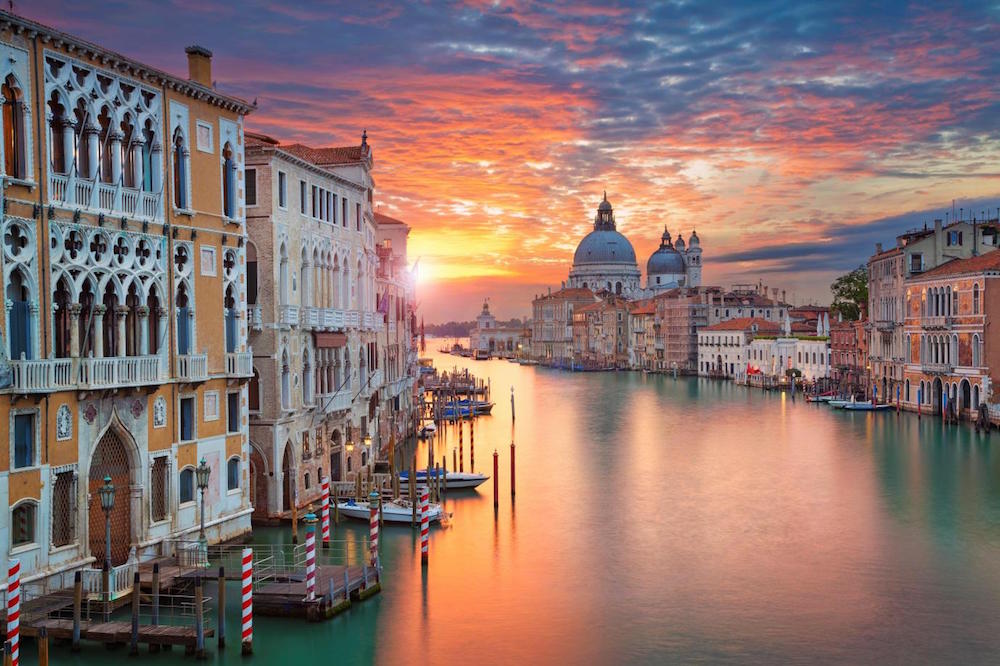
Venice is famed around the world for its canals and it stretches across 118 small islands in the marshy Venetian Lagoon along the Adriatic Sea in northeast Italy. The saltwater lagoon stretches along the shoreline between the mouths of the Po (south) and the Piave (north) Rivers. The Venetian Republic was a major maritime power during the Middle Ages and Renaissance and was used as a staging area for the Crusades, as well as a very important center of commerce (silk, grain and spices especially) and art in the 13th century up to the end of the 17th century.
The islands on which the city is built are connected by about 400 bridges spanning its 150 canals. In the old center, the canals serve the function of roads. In the 19th century a causeway to the mainland brought the railway to Venice, and another causeway with car parking was added in the 20th century (It costs about 25 euros a day). Beyond these land entrances at the northern edge of the city, transportation within the city remains, as it was in centuries past, is entirely on water or on foot making Venice Europe's largest urban ‘car free zone’, but still able to support a sizable functioning city in the 21st century.
The classical Venetian gondola is now mostly used for tourists, or for weddings, funerals or other ceremonies, with most Venetians travelling by motorised waterbuses (vaporetti) which ply regular routes along the major canals and between the city's islands. The only gondolas still in common use by Venetians are the traghetti, foot passenger ferries crossing the Grand Canal at certain points without bridges. Visitors can also take the water taxis between areas of the city.
Piazza San Marco (St Mark's Square), is the city’s principal square. As the central landmark and gathering place for Venice, Piazza San Marco is extremely popular with tourists, photographers and the Venetian pigeons. The Piazza originated in the 9th century as a small area in front of the original St Mark’s Basilica. It was enlarged to its present size and shape in 1177, when the Rio Batario, which had bounded it to the west, and a dock, which had isolated the Doge’s Palace from the square, were filled in, especially for a meeting between Pope Alexander III and the emperor Fredrick Barbarossa.
The first dry crossing of the Grand Canal was a pontoon bridge built in 1181. It was called the Ponte della Moneta, presumably because of the mint that stood near its eastern entrance. The present stone bridge, a single span designed by Antonio da Ponte, was finally completed in 1591. It is remarkably similar to the wooden bridge it succeeded. Two inclined ramps lead up to a central portico. On either side of the portico the covered ramps carry rows of shops. The engineering of the bridge was considered so audacious that architect Vincenzo Scamozzi predicted future ruin. The bridge has defied its critics to become one of the architectural icons of Venice.
The Bridge of Sighs ( Ponte dei Sospiri). This enclosed bridge is made of white limestone and has windows with stone bars. It passes over the Rio di Palazzo and connects the old prison to the interrogation rooms in the Doge’s Palace. The view from the Bridge of Sighs was the last view of Venice that convicts saw before their imprisonment. The bridge named by Lord Byron in the 19th century, comes from the suggestion that prisoners would sigh at their final view of beautiful Venice out the window before being taken down to their cells. A local legend says that lovers will be assured eternal love if they kiss on a gondola at sunset under the bridge.
Every major Italian city must have a patron Saint to bring it prosperity and luck, Venice’s is St Mark, but it has not always been the case. Two enterprising if unscrupulous merchants stole the bones of Saint Peter’s companion and author of the Gospel bearing his name from Alexandria in 828AD, thus returning them to Venice.
The islands on which the city is built are connected by about 400 bridges spanning its 150 canals. In the old center, the canals serve the function of roads. In the 19th century a causeway to the mainland brought the railway to Venice, and another causeway with car parking was added in the 20th century (It costs about 25 euros a day). Beyond these land entrances at the northern edge of the city, transportation within the city remains, as it was in centuries past, is entirely on water or on foot making Venice Europe's largest urban ‘car free zone’, but still able to support a sizable functioning city in the 21st century.
The classical Venetian gondola is now mostly used for tourists, or for weddings, funerals or other ceremonies, with most Venetians travelling by motorised waterbuses (vaporetti) which ply regular routes along the major canals and between the city's islands. The only gondolas still in common use by Venetians are the traghetti, foot passenger ferries crossing the Grand Canal at certain points without bridges. Visitors can also take the water taxis between areas of the city.
Piazza San Marco (St Mark's Square), is the city’s principal square. As the central landmark and gathering place for Venice, Piazza San Marco is extremely popular with tourists, photographers and the Venetian pigeons. The Piazza originated in the 9th century as a small area in front of the original St Mark’s Basilica. It was enlarged to its present size and shape in 1177, when the Rio Batario, which had bounded it to the west, and a dock, which had isolated the Doge’s Palace from the square, were filled in, especially for a meeting between Pope Alexander III and the emperor Fredrick Barbarossa.
The first dry crossing of the Grand Canal was a pontoon bridge built in 1181. It was called the Ponte della Moneta, presumably because of the mint that stood near its eastern entrance. The present stone bridge, a single span designed by Antonio da Ponte, was finally completed in 1591. It is remarkably similar to the wooden bridge it succeeded. Two inclined ramps lead up to a central portico. On either side of the portico the covered ramps carry rows of shops. The engineering of the bridge was considered so audacious that architect Vincenzo Scamozzi predicted future ruin. The bridge has defied its critics to become one of the architectural icons of Venice.
The Bridge of Sighs ( Ponte dei Sospiri). This enclosed bridge is made of white limestone and has windows with stone bars. It passes over the Rio di Palazzo and connects the old prison to the interrogation rooms in the Doge’s Palace. The view from the Bridge of Sighs was the last view of Venice that convicts saw before their imprisonment. The bridge named by Lord Byron in the 19th century, comes from the suggestion that prisoners would sigh at their final view of beautiful Venice out the window before being taken down to their cells. A local legend says that lovers will be assured eternal love if they kiss on a gondola at sunset under the bridge.
Every major Italian city must have a patron Saint to bring it prosperity and luck, Venice’s is St Mark, but it has not always been the case. Two enterprising if unscrupulous merchants stole the bones of Saint Peter’s companion and author of the Gospel bearing his name from Alexandria in 828AD, thus returning them to Venice.
Tuscany Villa Resort. SP47, Caprese Michelangelo 52033 Italy.
E-mail: tuscanyvillaresort@outlook.com
Phone: +39 348 6491134
E-mail: tuscanyvillaresort@outlook.com
Phone: +39 348 6491134
Website by Spaziale